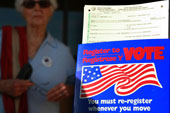- The latest voter registration rate suggests a continuation of the status quo.
The Secretary of State has released the first official report of registration for the 2014 campaign season—a midterm election with no presidential contest on the ballot. To date, 73.4% of eligible residents (or 17,660,257 Californians) have registered to vote. This percentage is well in line with registration rates over the past 50 years (about one or two points higher than recent midterm elections but slightly below the roughly 75% rate of the early 1990s). - Independents and minor party supporters are the growing categories.
The share of voters registered either as independents (officially called “no party preference” or “NPP” in California) or as minor party adherents is up 3 percentage points from four years ago (24.7% to 27.7%). Their share of the electorate has increased in every election year since 1990. Compared to four years ago, Democratic registration is down about a percentage point (44.6% to 43.6%) and Republican registration about two percentage points (30.8% to 28.7%). - The demographic composition of registered voters in California differs from the general population.
PPIC Statewide Surveys have consistently found differences between those who are registered to vote and the rest of the state. For example, whites account for 44% of California’s adult population but represent a majority of the state’s registered voters (56%), while Latinos constitute 33% of the adult population but only 22% of registered voters. Younger, less educated, less affluent Californians and those who rent rather than own their homes also account for a smaller share of registered voters than their representation in the broader population. The differences are even larger in the case of the subset of registered voters most likely to vote. - Independents are more likely to align with the politics of the Democratic Party.
Most independents in California consider themselves closer to the Democratic than the Republican Party (41% to 28%), although 31% do not identify with either party. In terms of ideology, 40% of independents consider themselves to be moderate or middle-of-the-road, compared to 30% each who call themselves liberal or conservative. On issues that divide Democrats and Republicans, independent voters often, although not always, agree with Democrats in the PPIC Statewide Surveys. For example, 69% of Democrats and 62% of independents favor same-sex marriage, while 58% of Republicans are opposed. In contrast, independents are divided on the issue of business regulation (47% say regulation is necessary, 48% believe it does more harm than good), while nearly six in 10 Democrats say regulation is necessary and eight in 10 Republicans view it as harmful. On all of these issues, independents who lean toward the Democratic Party hold different views than those who lean Republican. - Regional and statewide party trends are similar while a few district changes are noteworthy.
Changes in party registration in the state’s 15 largest counties (comprising 82% of the population) have largely tracked the statewide average, though there has been some variation in how the Republican and independent/other categories have shifted. The same is true for the state’s new congressional and legislative districts. In the roughly two years since the districts were drawn, their party complexion has changed in a fairly uniform way that matches statewide trends: roughly static Democratic registration, declining Republican registration, and climbing independent/other registration. The largest deviations from these broader trends have occurred in one area of Riverside County, where Assembly Districts 60 and 61, Senate District 31, and Congressional District 41 have seen a drop in the share of independent/other registration and an unusually large increase in Republican registration. There are also a few districts in California where Democrats have fared especially well compared to Republicans (AD 13 around Stockton and CD 47 in Long Beach and northern Orange County) and a few where the opposite has been true (AD 21 and SD 12 around Merced and CD 10 around Modesto).


Sources:PPIC Statewide Surveys, 2013. California Secretary of State, Reports of Registration (for the most recent registration numbers we used the 154 Day Report of Registration as of December 31, 2013). U.S. Census Bureau, 2010–2012 ACS dataset.
Supported with funding from the S. D. Bechtel, Jr. Foundation.
Topics
Political Landscape

